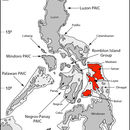en
names in breadcrumbs


Lizards of the genus Draco are commonly recognized as Southeast Asian Flying Lizards. This moderate-sized radiation of arboreal lizards is capable of long distance gliding using wing-like patagial membranes supported by elongate thoracic ribs (McGuire and Alcala, 2000). In the Philippines there exist an endemic and species-rich assemblage of species in this genus (McGuire and Alcala, 2000). One of these species is Draco reticulatus, recognized to occur on the islands of Bohol, Lapinig Chico, Leyte and Samar, all part of the Mindanao faunal region (Mindanao PAIC) in the southeastern Philippines. The ventral surface of this species patagium is homogenous salmon in males, occasionally with melanic spots near the margin, versus yellow in females with occasional melanic spots near the margin (McGuire and Alcala, 2000). In males of this species, the dewlap is triangular, and is reddish brown with a white spots near the body, and becomes orange-yellow near the tip (McGuire and Alcala, 2000). Several species in the Philippines are recognized to have widespread distributions (D. quadrasi, D. spilopterus); however, recent work indicates these species may actually be complexes of multiple, morphological similar species (McGuire and Alcala, 2000; McGuire and Heang, 2001).
Draco reticulatus can be distinguished from all other species of Draco in the Philippines by the following combination of characteristics: (1) moderately large size; (2) nostrils oriented laterally; (3) enlarged, thornlike supraciliary scale present; (4) dorsal scales variable in size, often with strong keeling; (5) tympana unsealed; (6) mode of six ribs supporting patagium; (7) lacrimal bone absent; (8) large black postrictal ocellus surrounding an enlarged white tubercle absent; (9-10) dorsal patagial coloration of both sexes composed of large pale spots within thin, dark brown to black reticulum, without enlarged, unscaled, chartreuse patches between ribs; (11) ventral surface of patagium salmon in most males, occasionally yellow, immaculate or with few small melanic spots near patagial margin; (12) ventral surface of patagium yellow in females, immaculate or with few small melanic spots near patagial margin; (13) males with triangular dewlap, reddish brown with white spots proximally, orange-yellow distally; (14) gray, tan, or brown dorsal body coloration in both sexes; (15) males with orbital region heavily suffused with dark pigments (information taken from McGuire and Alcala, 2000).
Draco reticulatus is known from the islands of Bohol, Lapinig Chico, Leyte, and Samar in the Philippines.
Draco reticulatus has been observed in sympatry with D. bimaculatus and D. ornatus on Bohol Island, where it was observed to occupy trees exposed to ample sunlight (McGuire and Alcala, 2000). Draco reticulatus appears to feed primarily on ants (McGuire, personal observation).
In a phylogenetic study of species in the genus Draco, McGuire and Heang (2001) recovered D. reticulatus as sister to D. cyanopterus from Mindanao Island. Together, the clade consisting of D. cyanopterus + D. reticulatus was sister to sampled populations of D. quadrasi from the central and western Philippines.
Draco reticulatus is recognized to occur in the Mindanao Pleistocene Aggregate Island Complex.
Draco reticulatus is recognized from relatively open habitats (McGuire and Alcala, 2000). This species likely was found along the edges of forest clearings and in relatively open areas before logging of the Philippine forests commenced (McGuire and Alcala, 2000). This species now occurs primarily in open coconut plantations where it is usually the only species of Draco encountered (McGuire and Alcala, 2000).
Maximum recorded SVL up to 91 mm
Draco reticulatus is a species of agamid lizard.[2] It is found in the Philippines.
{{cite journal}}: CS1 maint: multiple names: authors list (link) Draco reticulatus is a species of agamid lizard. It is found in the Philippines.